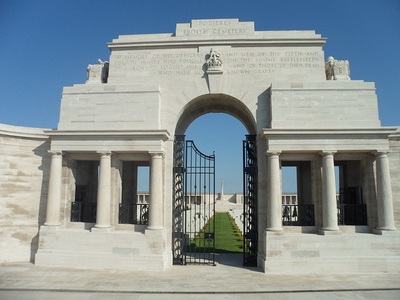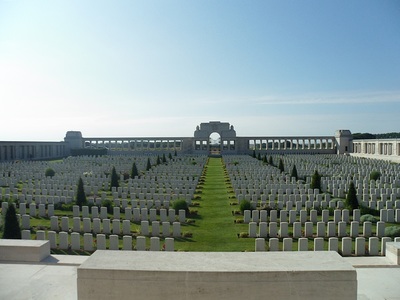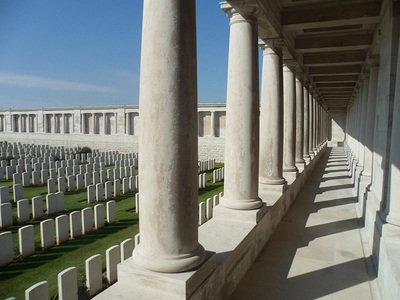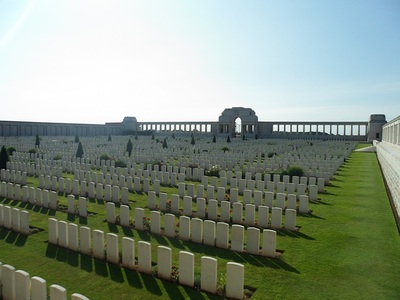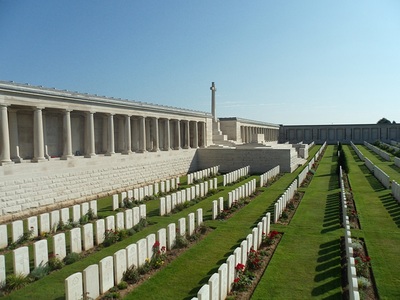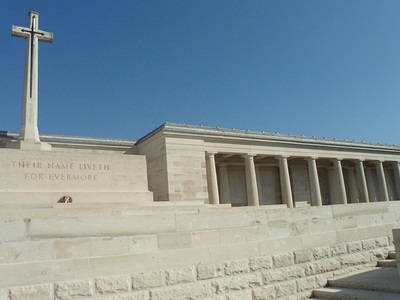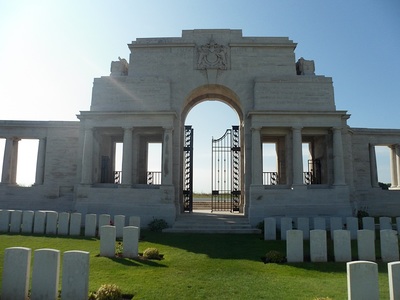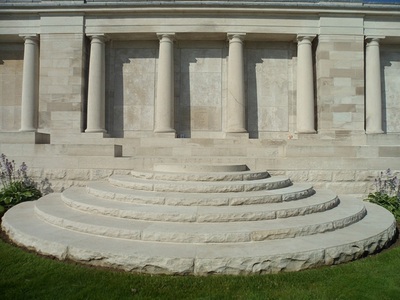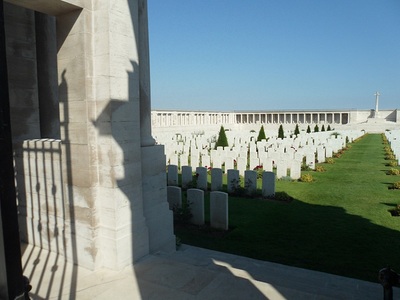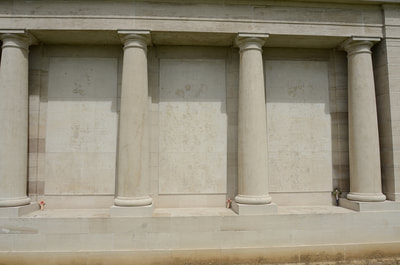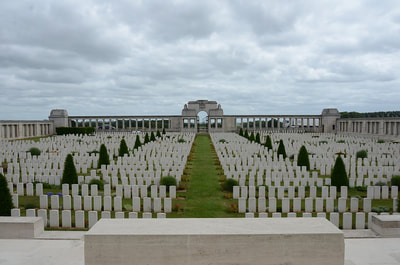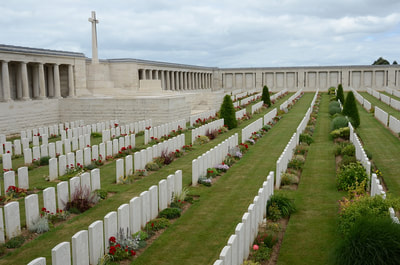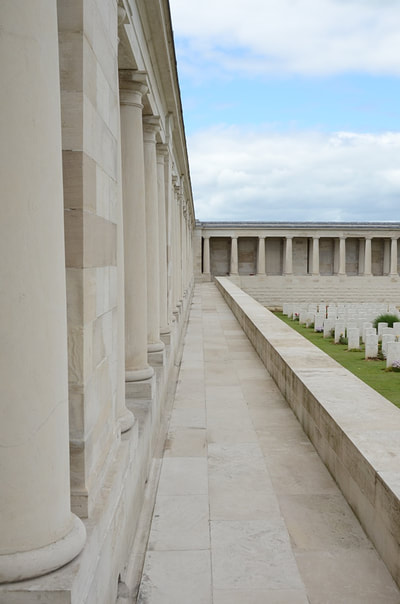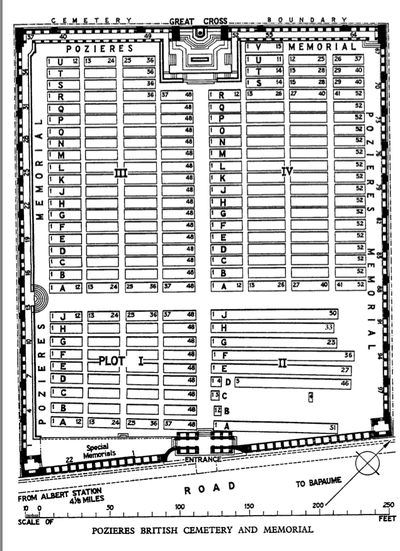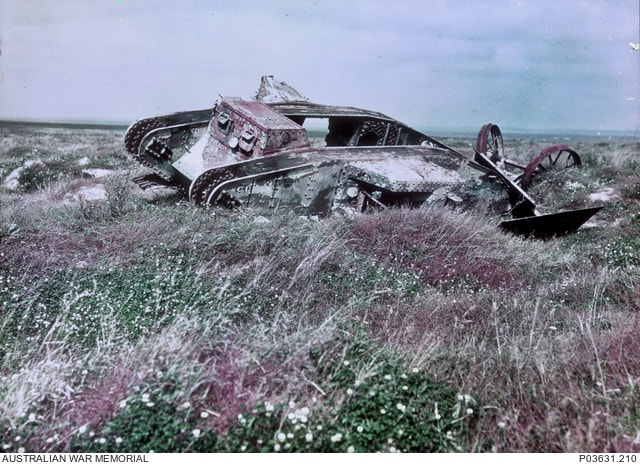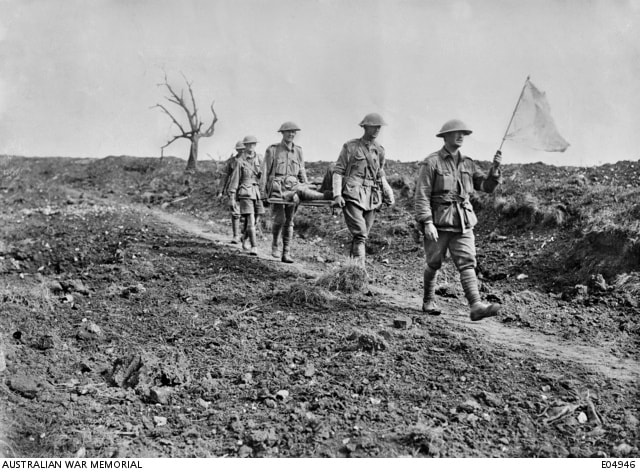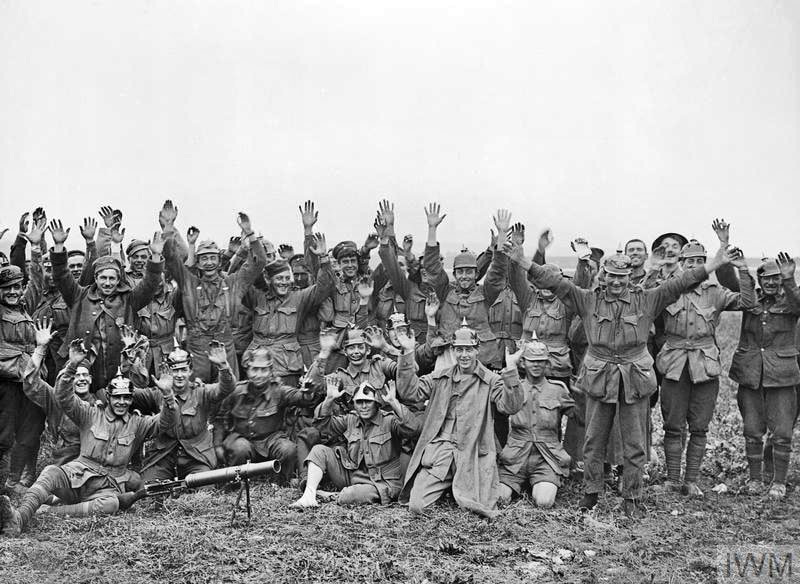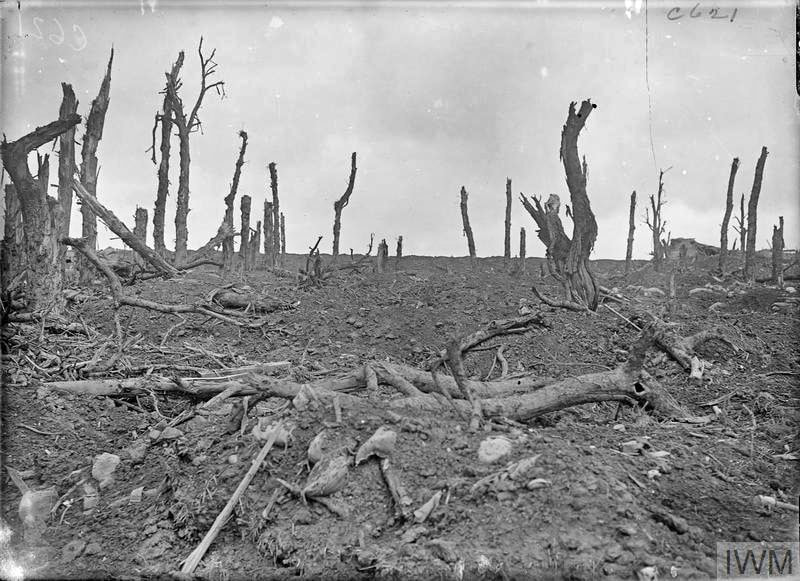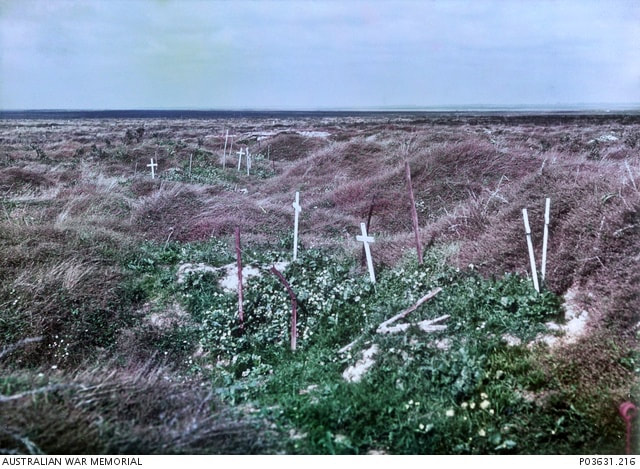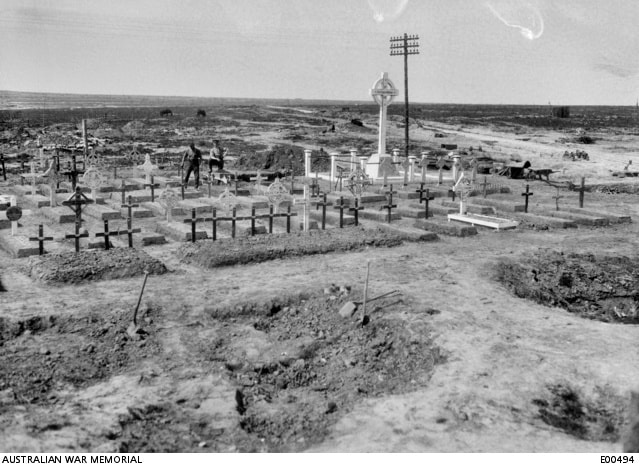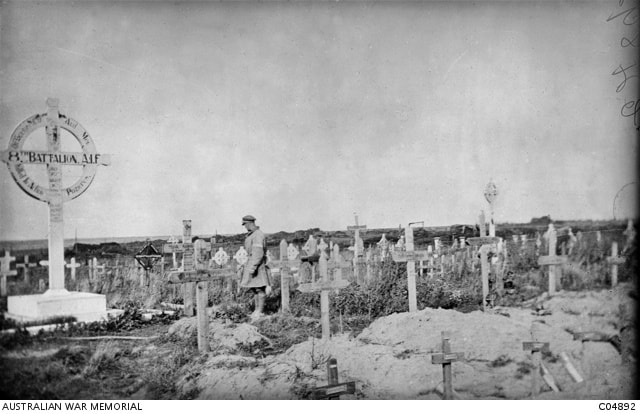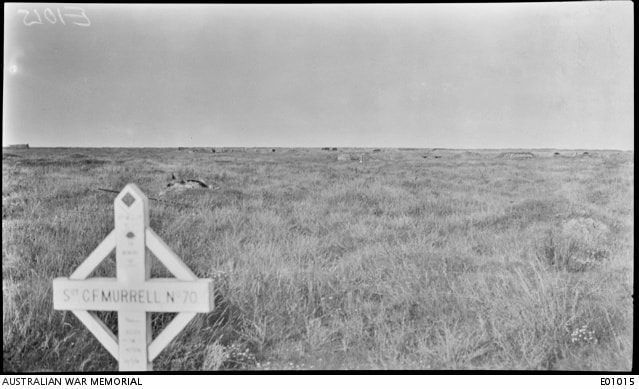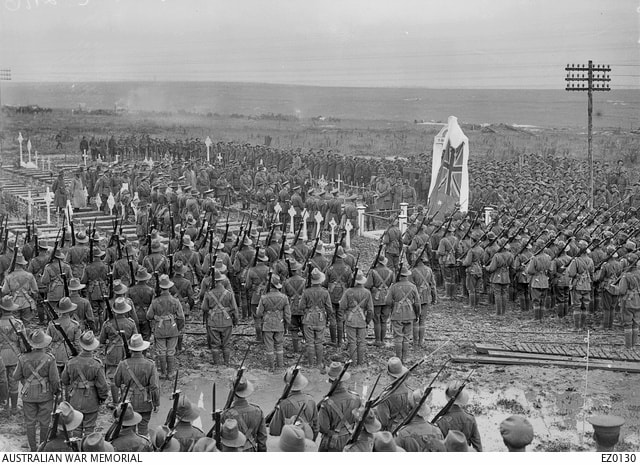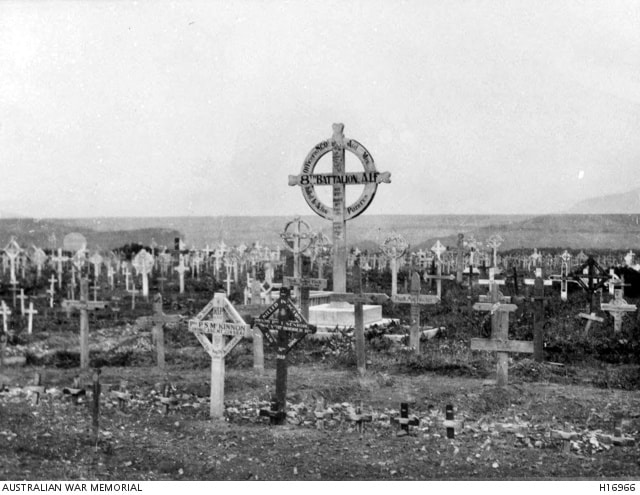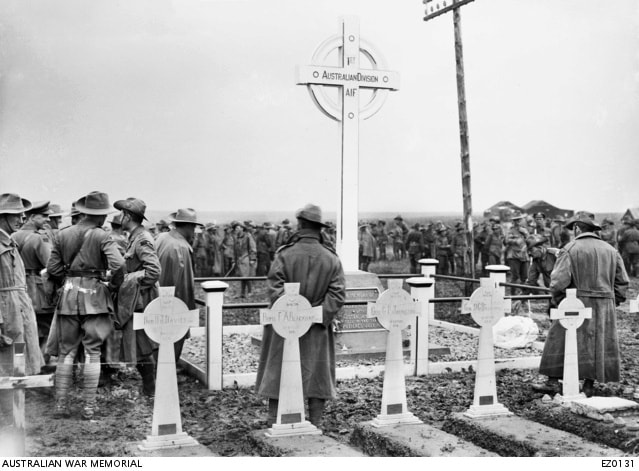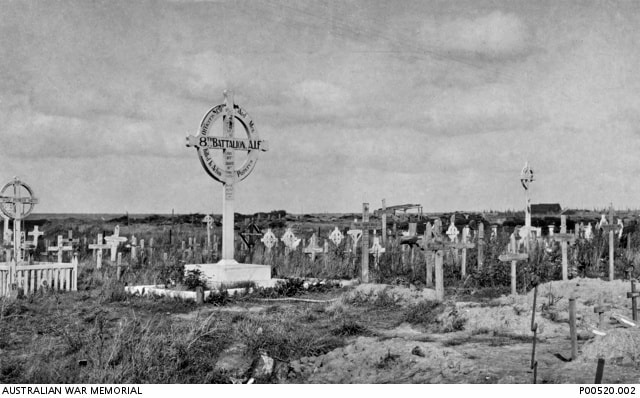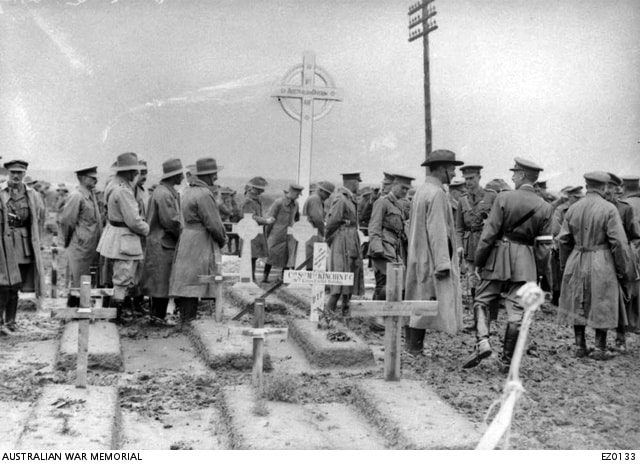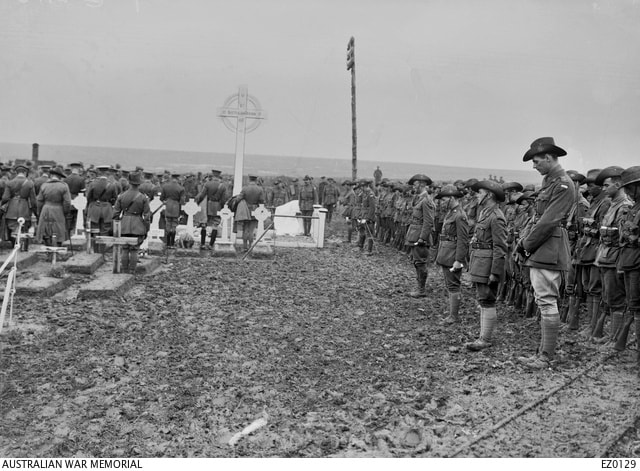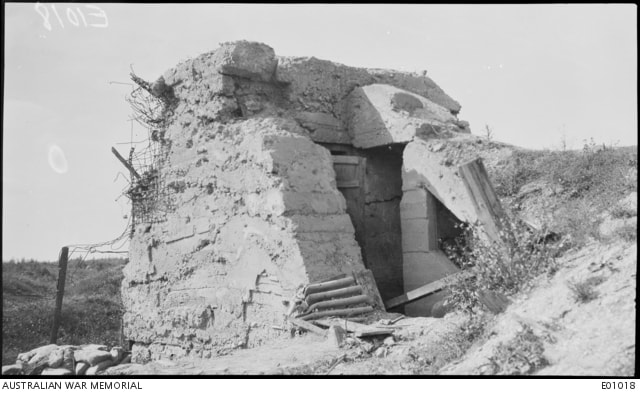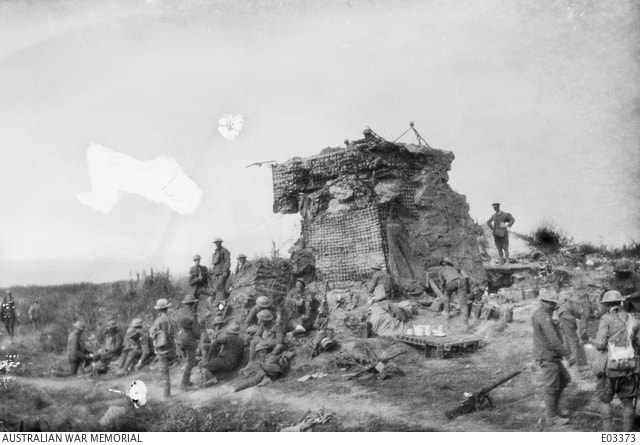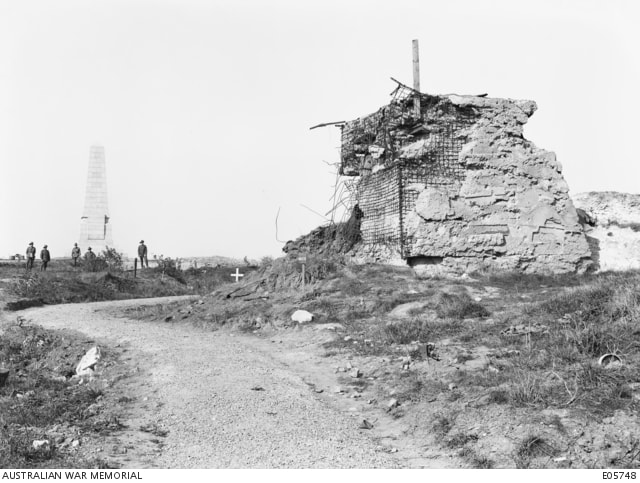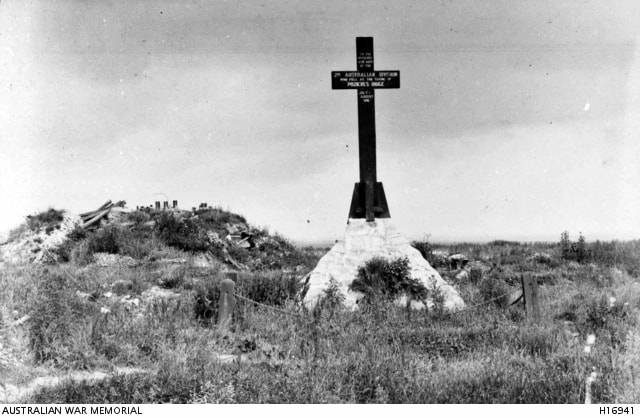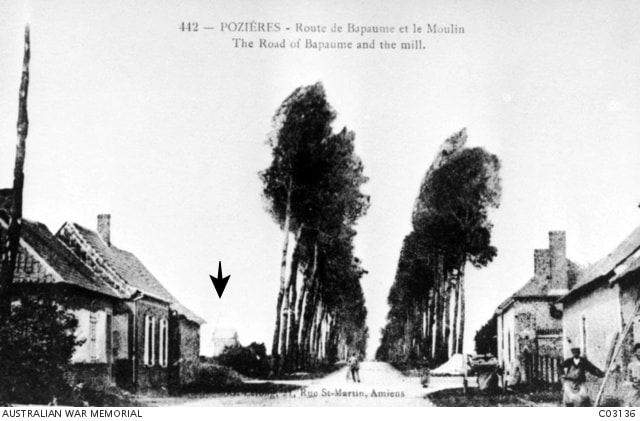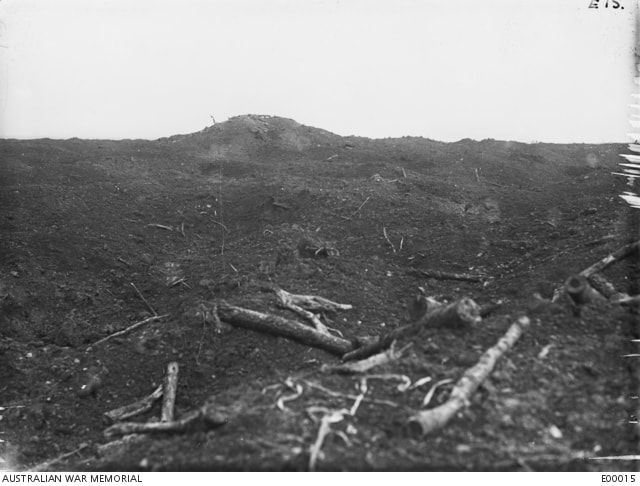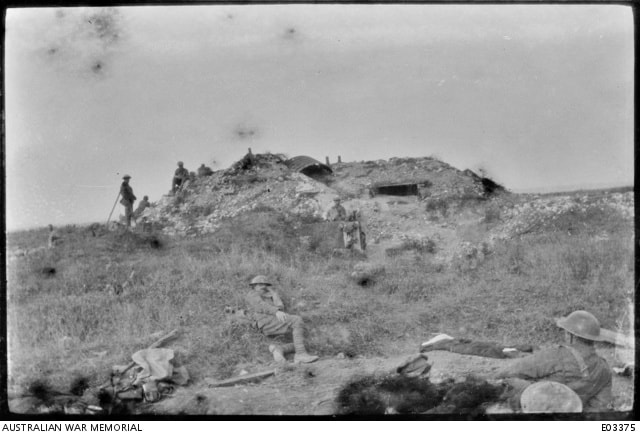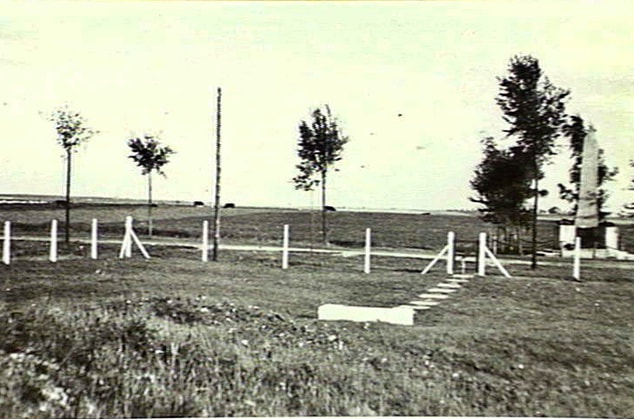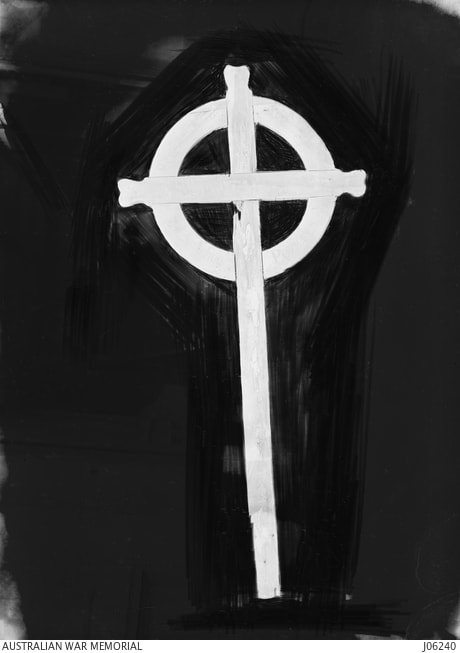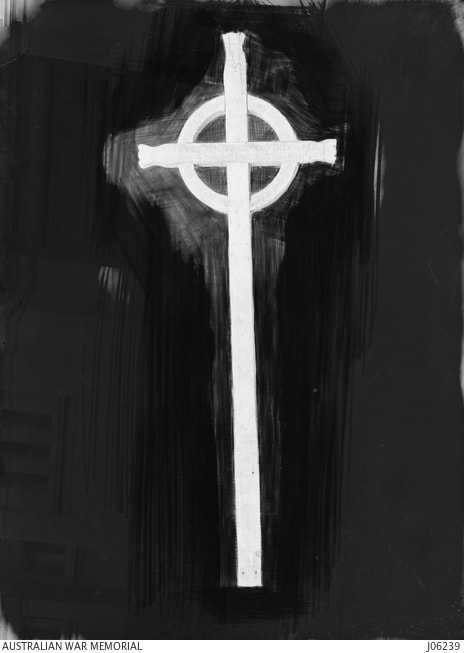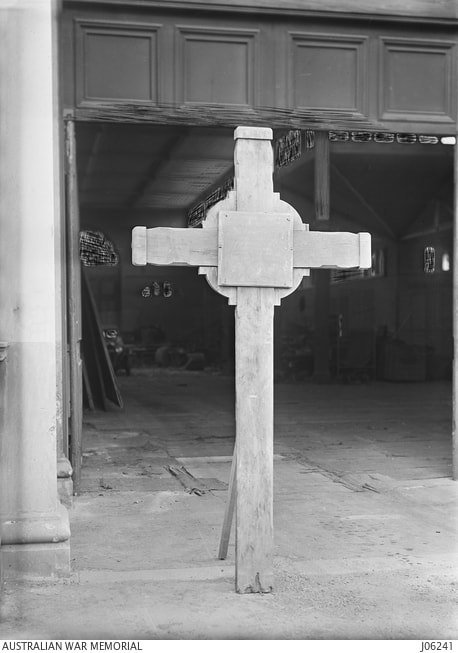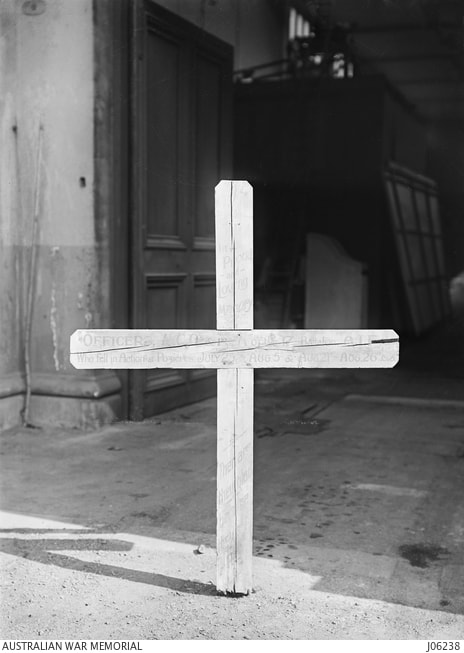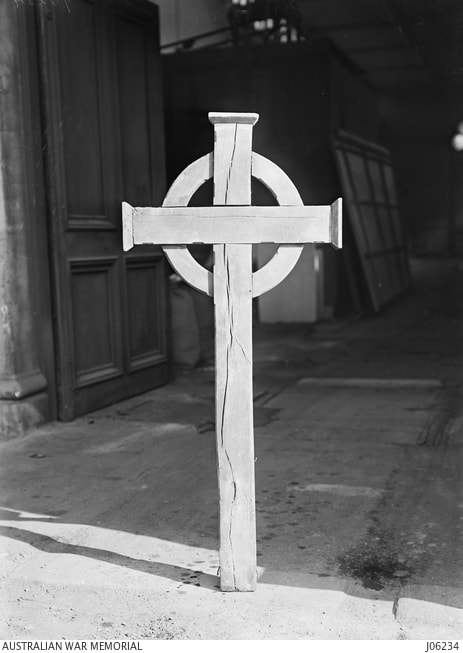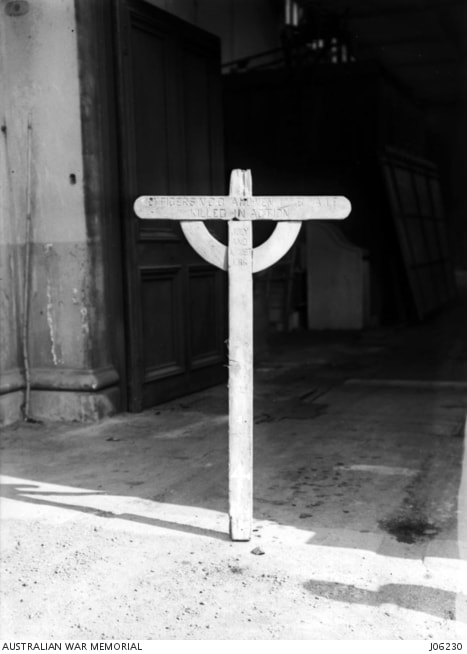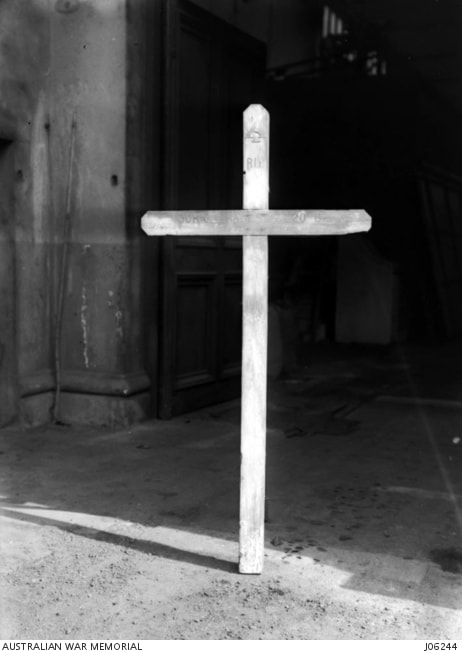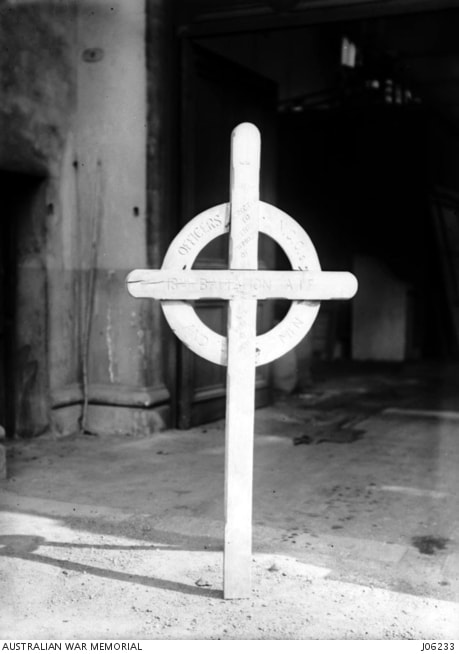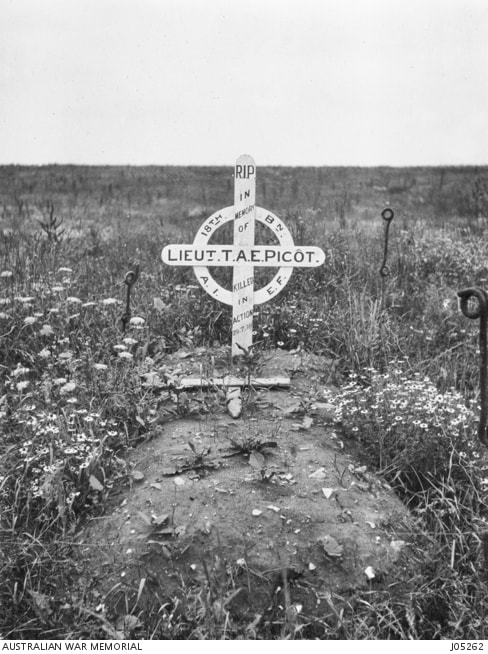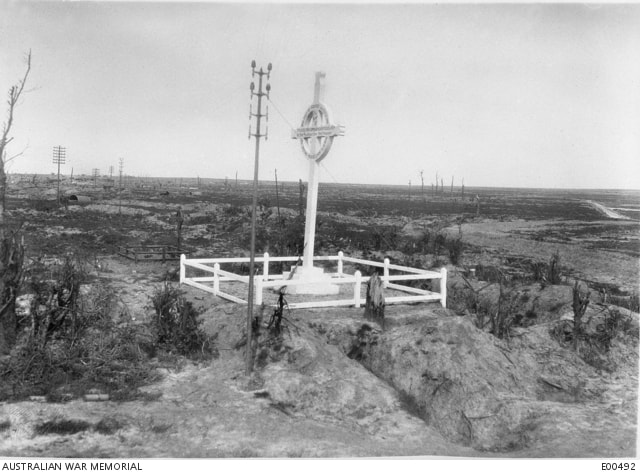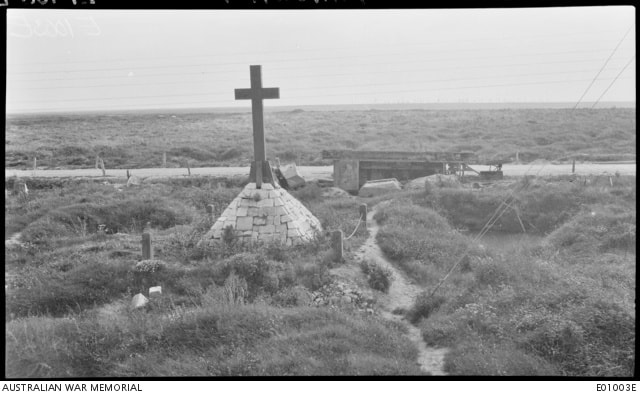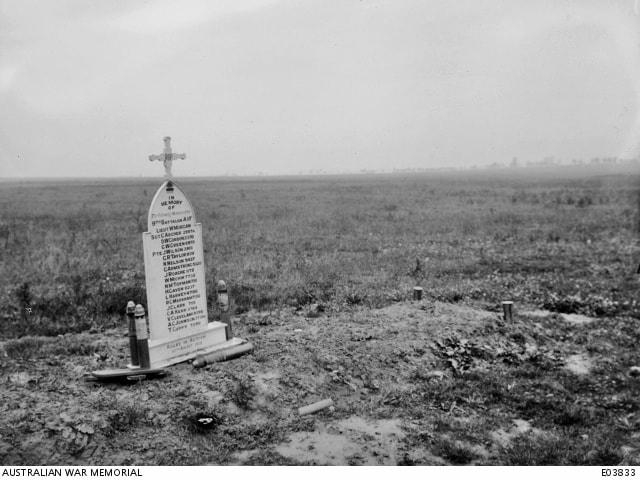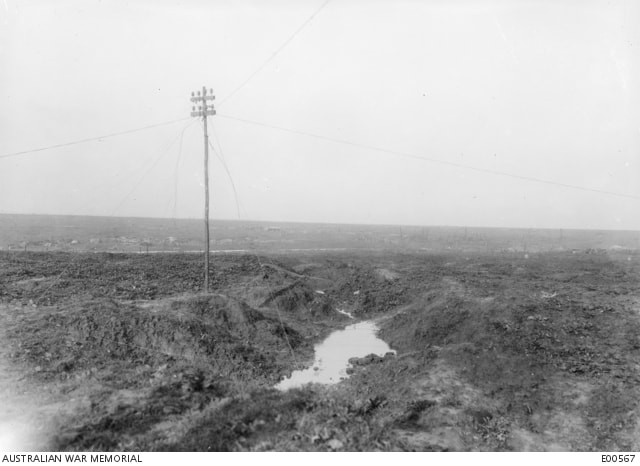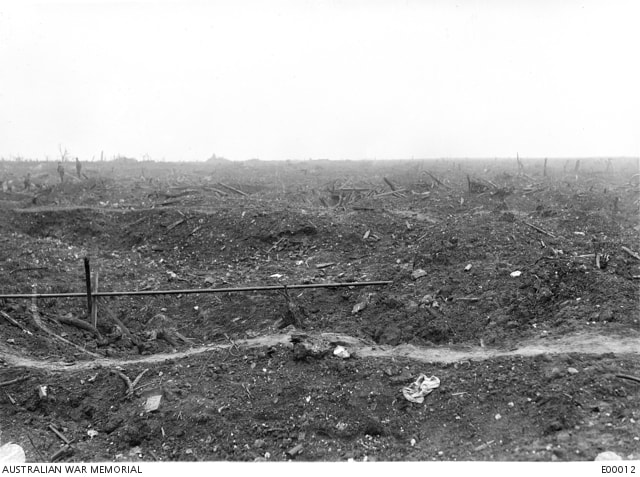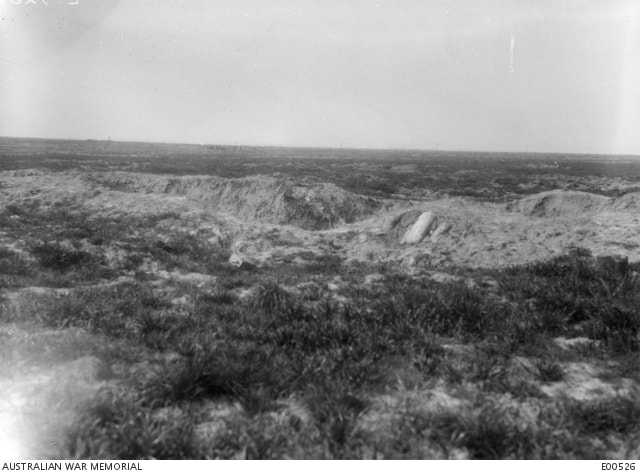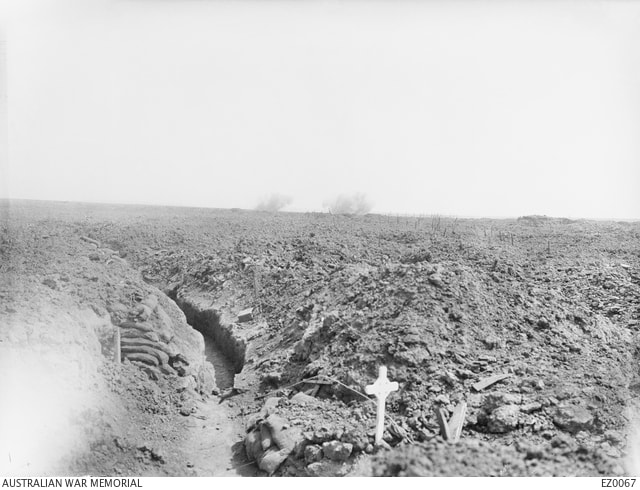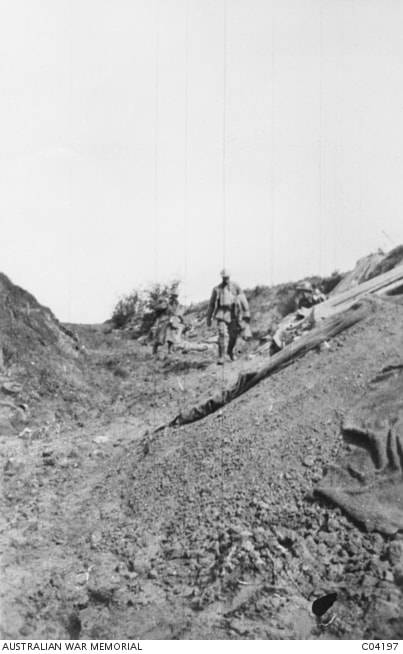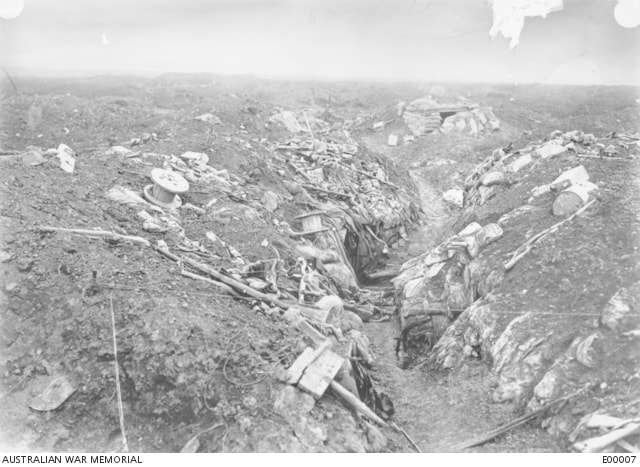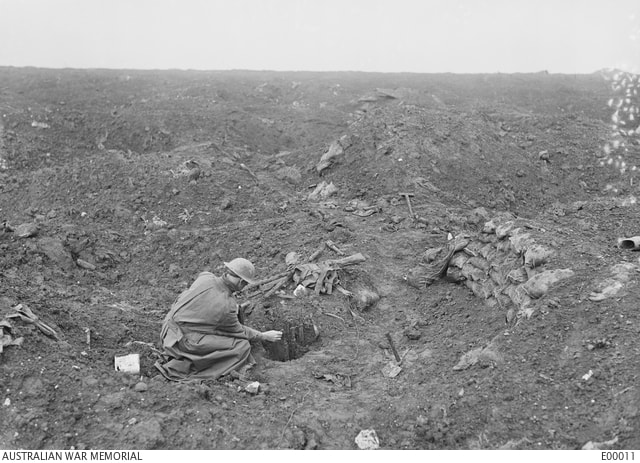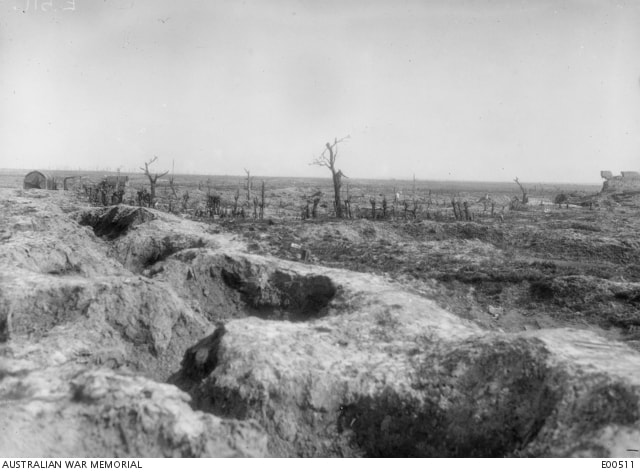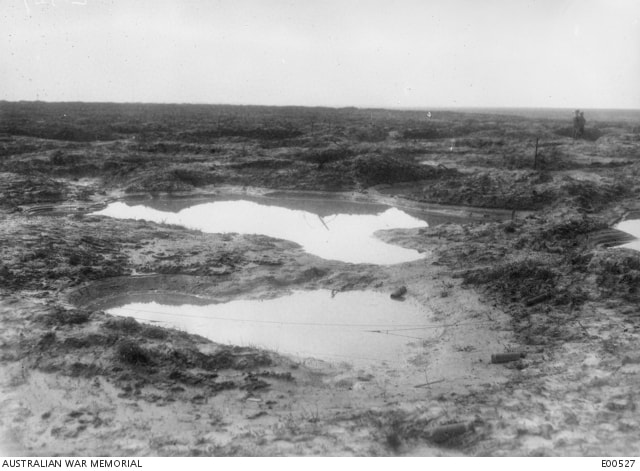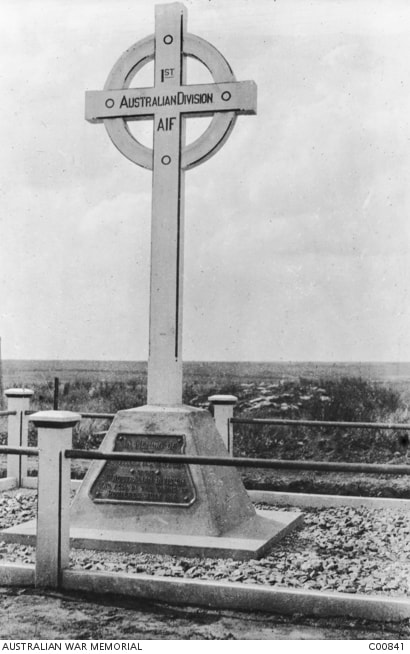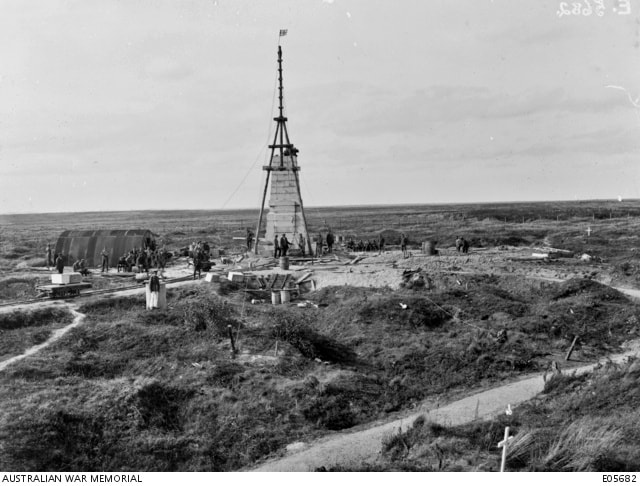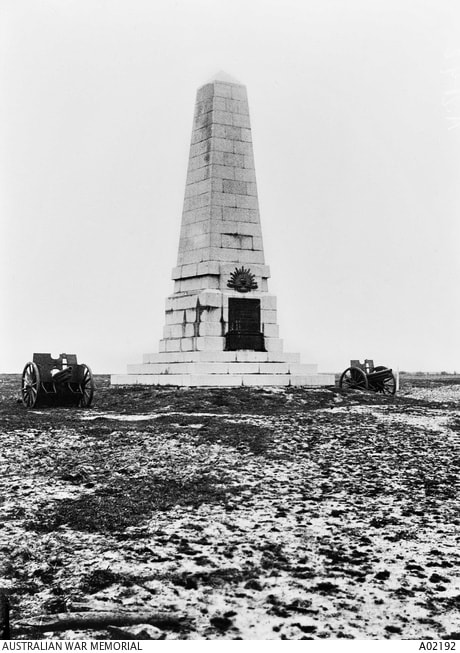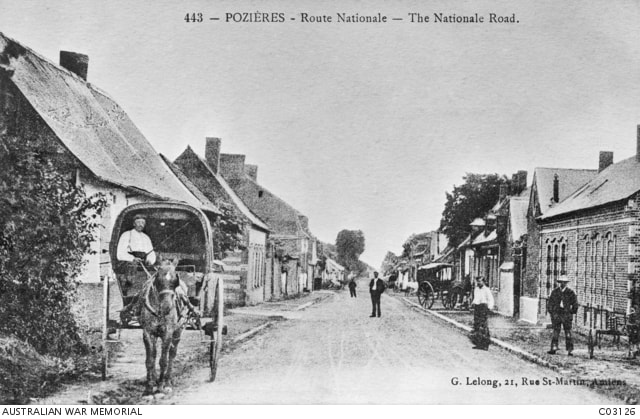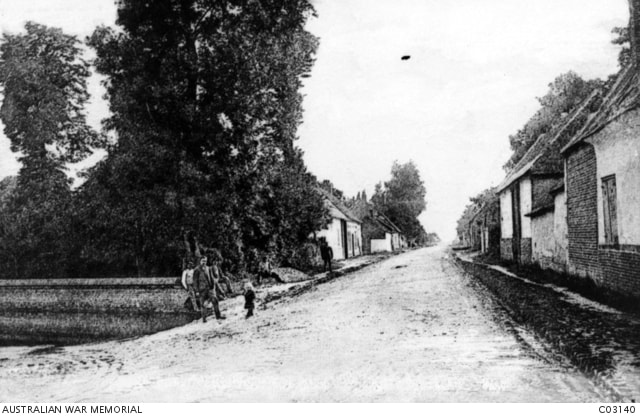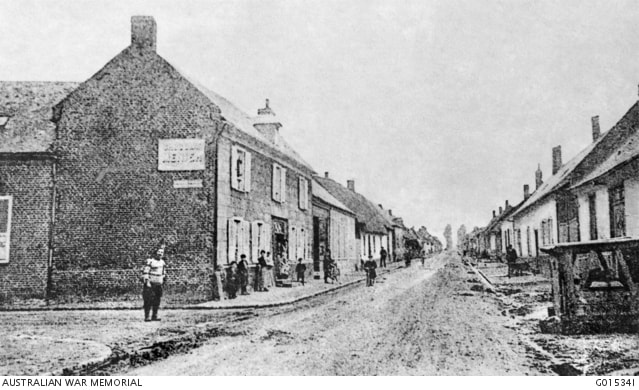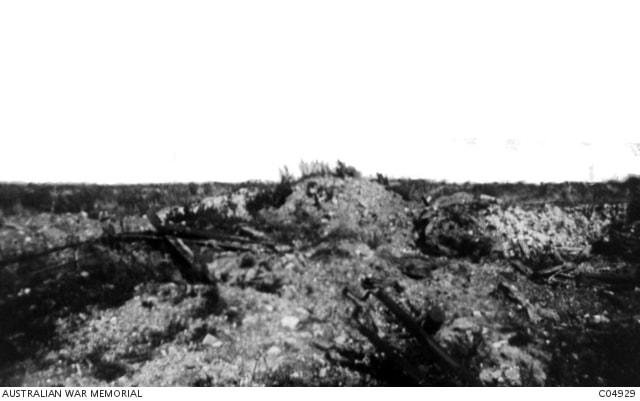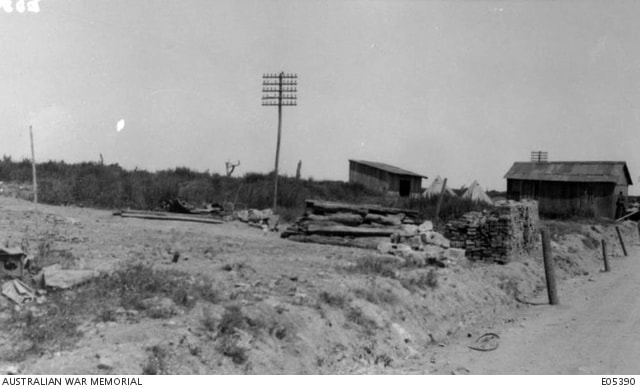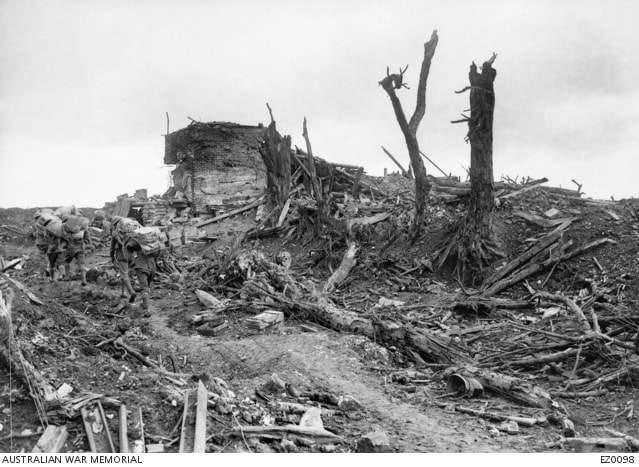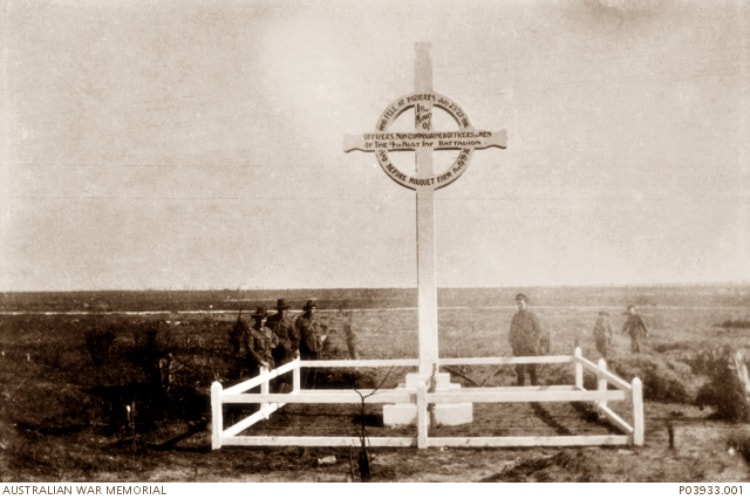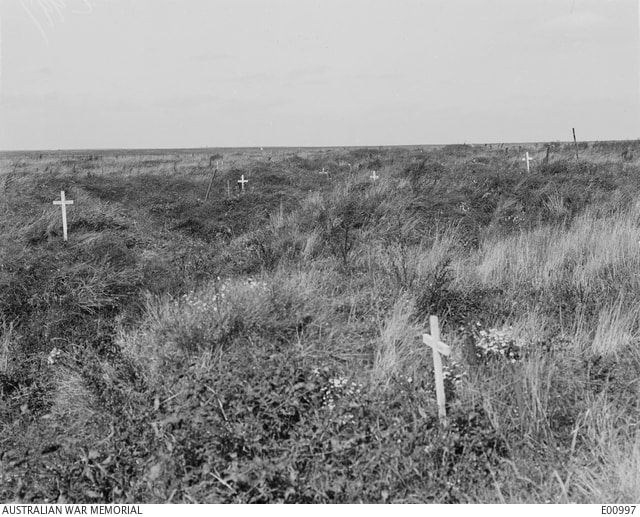POZIERES MEMORIAL
Somme
France
GPS Coordinates - GPS Coordinates - Latitude: 50.03371, Longitude: 2.71551
Roll of Honour
Listed by Surname
Location Information
Pozieres is a village 6 kilometres north-east of the town of Albert. The Memorial encloses Pozieres British Cemetery which is a little south-west of the village on the north side of the main road, D929, from Albert to Pozieres.
On the road frontage is an open arcade terminated by small buildings and broken in the middle by the entrance and gates. Along the sides and the back, stone tablets are fixed in the stone rubble walls bearing the names of the dead grouped under their Regiments.
It should be added that, although the memorial stands in a cemetery of largely Australian graves, it does not bear any Australian names. The Australian soldiers who fell in France and whose graves are not known are commemorated on the National Memorial at Villers-Bretonneux.
Visiting Information
The location or design of this site makes wheelchair access impossible.
The Panel Numbers quoted at the end of each entry relate to the panels dedicated to the Regiment served with. In some instances where a casualty is recorded as attached to another Regiment, his name may alternatively appear within their Regimental Panels. Please refer to the on-site Memorial Register Introduction to determine the alternative panel numbers if you do not find the name within the quoted Panels.
Historical InformationThe POZIERES MEMORIAL relates to the period of crisis in March and April 1918 when the Allied Fifth Army was driven back by overwhelming numbers across the former Somme battlefields, and the months that followed before the Advance to Victory, which began on 8 August 1918.
The Memorial commemorates over 14,000 casualties of the United Kingdom and 300 of the South African Forces who have no known grave and who died on the Somme from 21 March to 7 August 1918. The Corps and Regiments most largely represented are The Rifle Brigade with over 600 names, The Durham Light Infantry with approximately 600 names, the Machine Gun Corps with over 500, The Manchester Regiment with approximately 500 and The Royal Horse and Royal Field Artillery with over 400 names.
The memorial encloses POZIERES BRITISH CEMETERY, Plot II of which contains original burials of 1916, 1917 and 1918, carried out by fighting units and field ambulances. The remaining plots were made after the Armistice when graves were brought in from the battlefields immediately surrounding the cemetery, the majority of them of soldiers who died in the Autumn of 1916 during the latter stages of the Battle of the Somme, but a few represent the fighting in August 1918.
There are now 2,758 Commonwealth servicemen buried or commemorated in this cemetery. 1,380 of the burials are unidentified but there are special memorials to 23 casualties known or believed to be buried among them. There is also 1 German soldier buried here.
The cemetery and memorial were designed by W.H. Cowlishaw, with sculpture by Laurence A. Turner. The memorial was unveiled by Sir Horace Smith-Dorrien on 4 August 1930.
Dedications
29562 Private Frederick Gardiner, 2nd/6th Bn. Royal Warwickshire Regiment, 1st April 1918, aged 35.
Remembered by great nephew, Eddie Gardiner.
830629 Driver William Thomas Hogan, M. M., 33rd Bde. Royal Field Artillery, 21st March 1918, aged 31.
Son of the late Thomas and Bridget Hogan; husband of Florence Gertrude Hogan, of 12, Habberley St., Kidderminster, Worcs.
Remembered by grand-daughter Barbara Box.
43159 Private James Lawson, 6th Bn. Northamptonshire Regiment, 3rd April 1918, aged 29.
Remembered by great niece, Amanda L. Rose.
303395 Lance Corporal James Alfred Ryder, M. M., 2nd/6th Bn. Manchester Regiment, 21st March 1918, aged 33.
Remembered by great nephew, Jack Ryder
Pozieres is a village 6 kilometres north-east of the town of Albert. The Memorial encloses Pozieres British Cemetery which is a little south-west of the village on the north side of the main road, D929, from Albert to Pozieres.
On the road frontage is an open arcade terminated by small buildings and broken in the middle by the entrance and gates. Along the sides and the back, stone tablets are fixed in the stone rubble walls bearing the names of the dead grouped under their Regiments.
It should be added that, although the memorial stands in a cemetery of largely Australian graves, it does not bear any Australian names. The Australian soldiers who fell in France and whose graves are not known are commemorated on the National Memorial at Villers-Bretonneux.
Visiting Information
The location or design of this site makes wheelchair access impossible.
The Panel Numbers quoted at the end of each entry relate to the panels dedicated to the Regiment served with. In some instances where a casualty is recorded as attached to another Regiment, his name may alternatively appear within their Regimental Panels. Please refer to the on-site Memorial Register Introduction to determine the alternative panel numbers if you do not find the name within the quoted Panels.
Historical InformationThe POZIERES MEMORIAL relates to the period of crisis in March and April 1918 when the Allied Fifth Army was driven back by overwhelming numbers across the former Somme battlefields, and the months that followed before the Advance to Victory, which began on 8 August 1918.
The Memorial commemorates over 14,000 casualties of the United Kingdom and 300 of the South African Forces who have no known grave and who died on the Somme from 21 March to 7 August 1918. The Corps and Regiments most largely represented are The Rifle Brigade with over 600 names, The Durham Light Infantry with approximately 600 names, the Machine Gun Corps with over 500, The Manchester Regiment with approximately 500 and The Royal Horse and Royal Field Artillery with over 400 names.
The memorial encloses POZIERES BRITISH CEMETERY, Plot II of which contains original burials of 1916, 1917 and 1918, carried out by fighting units and field ambulances. The remaining plots were made after the Armistice when graves were brought in from the battlefields immediately surrounding the cemetery, the majority of them of soldiers who died in the Autumn of 1916 during the latter stages of the Battle of the Somme, but a few represent the fighting in August 1918.
There are now 2,758 Commonwealth servicemen buried or commemorated in this cemetery. 1,380 of the burials are unidentified but there are special memorials to 23 casualties known or believed to be buried among them. There is also 1 German soldier buried here.
The cemetery and memorial were designed by W.H. Cowlishaw, with sculpture by Laurence A. Turner. The memorial was unveiled by Sir Horace Smith-Dorrien on 4 August 1930.
Dedications
29562 Private Frederick Gardiner, 2nd/6th Bn. Royal Warwickshire Regiment, 1st April 1918, aged 35.
Remembered by great nephew, Eddie Gardiner.
830629 Driver William Thomas Hogan, M. M., 33rd Bde. Royal Field Artillery, 21st March 1918, aged 31.
Son of the late Thomas and Bridget Hogan; husband of Florence Gertrude Hogan, of 12, Habberley St., Kidderminster, Worcs.
Remembered by grand-daughter Barbara Box.
43159 Private James Lawson, 6th Bn. Northamptonshire Regiment, 3rd April 1918, aged 29.
Remembered by great niece, Amanda L. Rose.
303395 Lance Corporal James Alfred Ryder, M. M., 2nd/6th Bn. Manchester Regiment, 21st March 1918, aged 33.
Remembered by great nephew, Jack Ryder
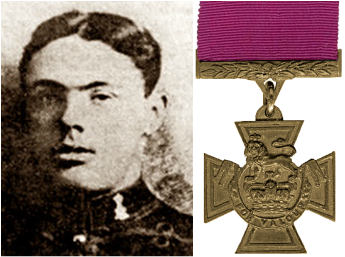
50720 Private Herbert George Columbine V. C.
9th Squadron, Machine Gun Corps (Cavalry), died 22nd March 1918, aged 24. Panel 93 & 94.
Son of Mrs. Emma Columbine.
Citation: An extract from "The London Gazette," dated 30th April, 1918, records the following:- "For most conspicuous bravery and self-sacrifice displayed, when, owing to casualties, Pte. Columbine took over command of a gun and kept it firing from 9 a.m. till 1 p.m. in an isolated position with no wire in front. During this time wave after wave of the enemy failed to get up to him. Owing to his being attacked by a low-flying aeroplane the enemy at last gained a strong footing in the trench on either side. The position being untenable he ordered the two remaining men to get away, and, though being bombed from either side, kept his gun firing and inflicting tremendous losses. He was eventually killed by a bomb which blew up him and his gun. He showed throughout the highest valour, determination and self-sacrifice."
9th Squadron, Machine Gun Corps (Cavalry), died 22nd March 1918, aged 24. Panel 93 & 94.
Son of Mrs. Emma Columbine.
Citation: An extract from "The London Gazette," dated 30th April, 1918, records the following:- "For most conspicuous bravery and self-sacrifice displayed, when, owing to casualties, Pte. Columbine took over command of a gun and kept it firing from 9 a.m. till 1 p.m. in an isolated position with no wire in front. During this time wave after wave of the enemy failed to get up to him. Owing to his being attacked by a low-flying aeroplane the enemy at last gained a strong footing in the trench on either side. The position being untenable he ordered the two remaining men to get away, and, though being bombed from either side, kept his gun firing and inflicting tremendous losses. He was eventually killed by a bomb which blew up him and his gun. He showed throughout the highest valour, determination and self-sacrifice."
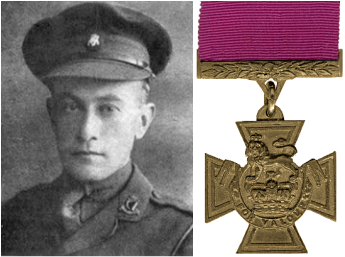
Second Lieutenant Edmund De Wind V. C.
15th Bn. Royal Irish Rifles, died 21st March 1918, aged 34. Panel 74 to 76.
Son of the late Arthur Hughes De Wind, C.E., and Margaret Jane De Wind, of "Kinvara", Comber, Co. Down.
Citation: An extract from "The London Gazette," dated 13th May, 1919, records the following:- "For most conspicuous bravery and self-sacrifice on the 21st March, 1918, at the Race Course Redoubt, near Grugies. For seven hours he held this most important post, and though twice wounded and practically single-handed, he maintained his position until another section could be got to his help. On two occasions, with two N.C.O.'s only, he got out on top under heavy machine gun and rifle fire, and cleared the enemy out of the trench, killing many. He continued to repel attack after attack until he was mortally wounded and collapsed. His valour, self-sacrifice and example were of the highest order."
15th Bn. Royal Irish Rifles, died 21st March 1918, aged 34. Panel 74 to 76.
Son of the late Arthur Hughes De Wind, C.E., and Margaret Jane De Wind, of "Kinvara", Comber, Co. Down.
Citation: An extract from "The London Gazette," dated 13th May, 1919, records the following:- "For most conspicuous bravery and self-sacrifice on the 21st March, 1918, at the Race Course Redoubt, near Grugies. For seven hours he held this most important post, and though twice wounded and practically single-handed, he maintained his position until another section could be got to his help. On two occasions, with two N.C.O.'s only, he got out on top under heavy machine gun and rifle fire, and cleared the enemy out of the trench, killing many. He continued to repel attack after attack until he was mortally wounded and collapsed. His valour, self-sacrifice and example were of the highest order."

Lieutenant Colonel Wilfrid Elstob V. C., D. S. O., M. C.
16th Bn. Manchester Regiment, died 21st March 1918, aged 29. Panel 64 to 67.
Son of the Rev. Canon J. G. Elstob and Frances Alice Elstob, of "Fanshawe", Chelford, Cheshire.
Citation: An extract from the "London Gazette", dated 6th June, 1919, records the following:- "For most conspicuous bravery, devotion to duty and self-sacrifice during operations at Manchester Redoubt, near St. Quentin, on the 21st March, 1918. During the preliminary bombardment he encouraged his men in the posts in the Redoubt by frequent visits, and when repeated attacks developed controlled the defence at the points threatened, giving personal support with revolver, rifle and bombs. Single-handed he repulsed one bombing assault driving back the enemy and inflicting severe casualties. Later, when ammunition was required, he made several journeys under severe fire in order to replenish the supply. Throughout the day Lieutenant-Colonel Elstob, although twice wounded, showed the most fearless disregard of his own safety, and by his encouragement and noble example inspired his command to the fullest degree. The Manchester Redoubt was surrounded in the first wave of the enemy attack, but by means of the buried cable Lieutenant-Colonel Elstob was able to assure his Brigade Commander that "The Manchester Regiment will defend Manchester Hill to the last." Sometime after this post was overcome by vastly superior forces, and this very gallant officer was killed in the final assault, having maintained to the end the duty which he had impressed on his men - namely, "Here we fight, and here we die." He set throughout the highest example of valour, determination, endurance and fine soldierly bearing."
16th Bn. Manchester Regiment, died 21st March 1918, aged 29. Panel 64 to 67.
Son of the Rev. Canon J. G. Elstob and Frances Alice Elstob, of "Fanshawe", Chelford, Cheshire.
Citation: An extract from the "London Gazette", dated 6th June, 1919, records the following:- "For most conspicuous bravery, devotion to duty and self-sacrifice during operations at Manchester Redoubt, near St. Quentin, on the 21st March, 1918. During the preliminary bombardment he encouraged his men in the posts in the Redoubt by frequent visits, and when repeated attacks developed controlled the defence at the points threatened, giving personal support with revolver, rifle and bombs. Single-handed he repulsed one bombing assault driving back the enemy and inflicting severe casualties. Later, when ammunition was required, he made several journeys under severe fire in order to replenish the supply. Throughout the day Lieutenant-Colonel Elstob, although twice wounded, showed the most fearless disregard of his own safety, and by his encouragement and noble example inspired his command to the fullest degree. The Manchester Redoubt was surrounded in the first wave of the enemy attack, but by means of the buried cable Lieutenant-Colonel Elstob was able to assure his Brigade Commander that "The Manchester Regiment will defend Manchester Hill to the last." Sometime after this post was overcome by vastly superior forces, and this very gallant officer was killed in the final assault, having maintained to the end the duty which he had impressed on his men - namely, "Here we fight, and here we die." He set throughout the highest example of valour, determination, endurance and fine soldierly bearing."
'Gibraltar"
On the western edge of the village of Pozieres was a large, heavily fortified blockhouse, given the name 'Gibraltar' by British troops, it was captured from the Germans when the Australian First Division attacked, took and held Pozières village between 23 and 26 July 1916. It was later lost during the German offensive of 1918 and finally recaptured in August 1918.
The Windmill
The Windmill site at Pozières was established as an Australian memorial in the 1930s at the suggestion of Australia's official war historian, Charles Bean, because, 'The Windmill site … marks a ridge more densely sown with Australian sacrifice than any other place on earth'. Over seven weeks in 1916, at the Battle of the Somme, the Australian Imperial Force suffered 23 000 casualties, more than 6700 of whom died, in the countryside around the Windmill. On 11 November 1993 soil from the Windmill site was cast over the coffin of Australia's Unknown Soldier during his funeral at the Australian War Memorial in Canberra.
© Commonwealth of Australia 2017
© Commonwealth of Australia 2017
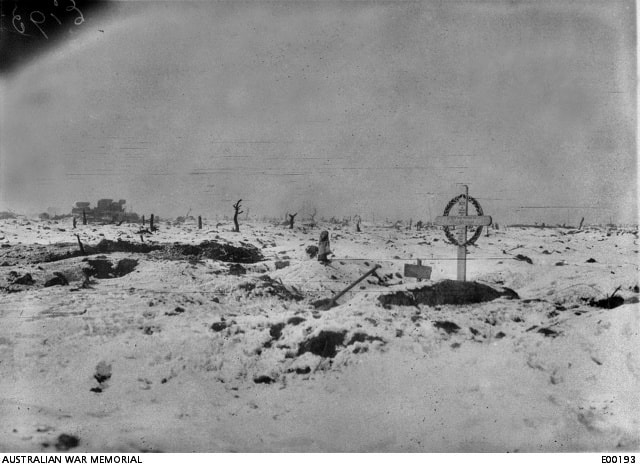
4th February 1917; The battlefield in Pozieres near the school house where the 12th Battalion was entrenched. The grave is that of Captain Ivor Stephen Margetts, of Wynyard, Tas, who served in the 12th Battalion and was killed in action on 24 July 1916. The German Spring Offensive in 1918 re-captured this area and Margetts' grave was obliterated and was lost. His name is commemorated on the Villers-Bretonneux Memorial.
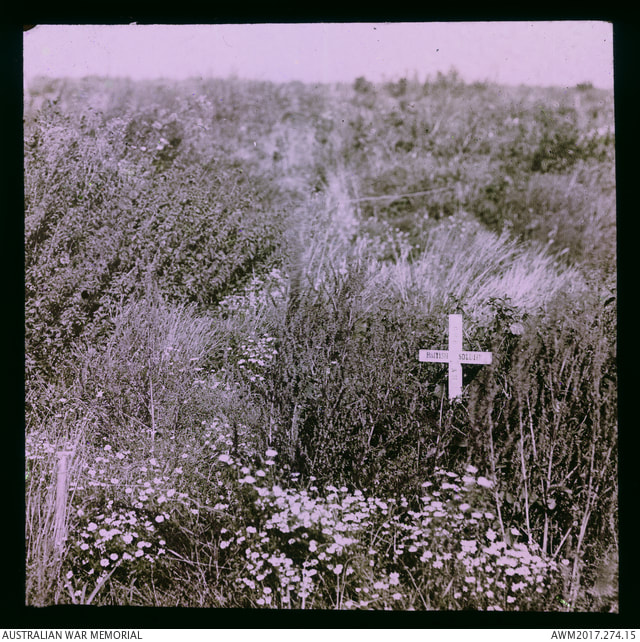
September 1917; An unidentified soldier's grave half obscured by wind sown flowers, on the old battlefield of Pozieres. The cross marking the grave reads 'British Soldier'. Photographers Hurley and Hubert Wilkins often walked the site of the former village of Pozieres during their visits to the British War Office photograph censor in 1917. Of the area, then covered by wild flowers, Hurley remarked following one of their visits: “one was beyond the war afflicted zone – (it being only about 30 miles away!!) and there was nothing whatever to convey any warlike impressions – everything was so quiet and peaceful”. The fighting returned to this area in March 1918.
1st Australian Division Memorial
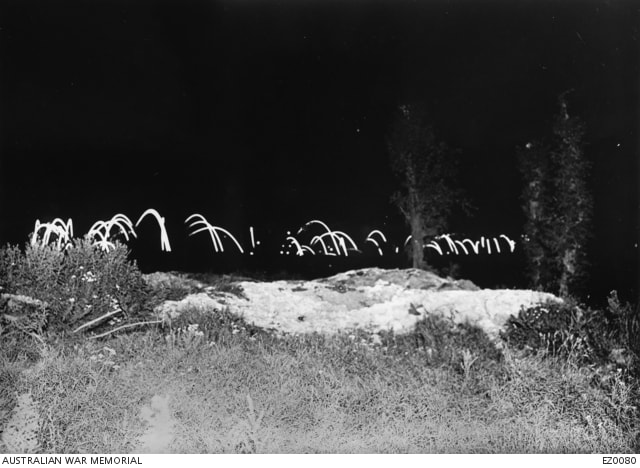
27th August 1916; Shell fire and flares towards Pozieres. The pinpoints are bursts of shrapnel. The curved lines show the effect on the negative of Verey lights sent up by the Germans from front line trenches to illuminate an area where a raid is expected. Verey lights were flares used for signalling at night and lighting; they came in several colours and were fired from a pistol.
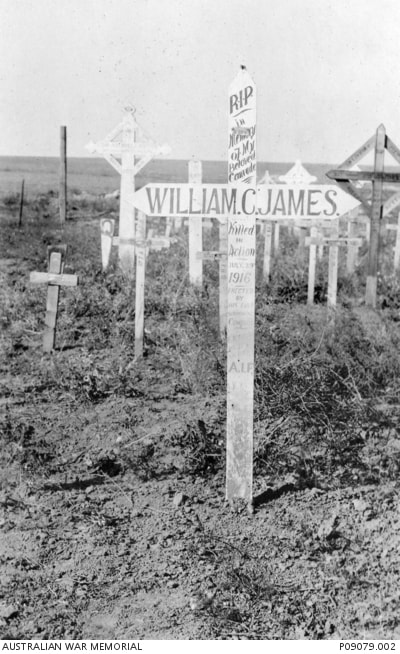
Grave of 3308 Private (Pte) William Charles James, 12th Field Ambulance Australian Army Medical Corps, of Richmond, Vic. A coachbuilder prior to enlistment he embarked from Melbourne on board HMAT Nestor (A71) on 11 October 1915. Pte James served in France; he was killed in action on 29 July 1916, aged 20. He is buried at the Pozieres British Cemetery, Ovillers-La Boisselle. The inscription on the cross reads "In memory of my beloved comrade".


